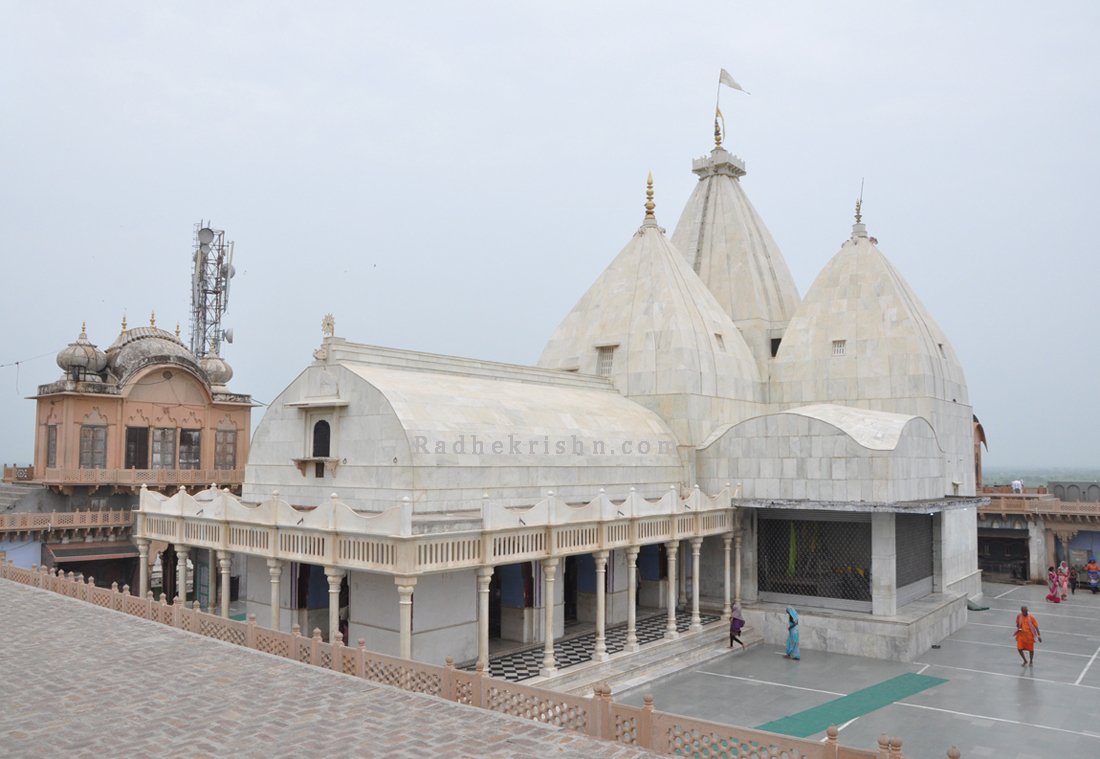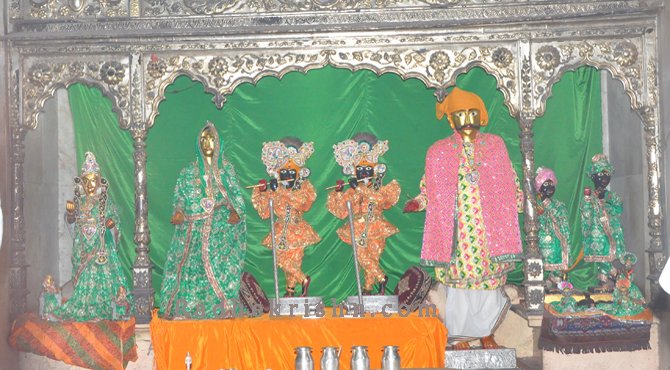seeing through the eyes of scriptures
Manaḥ Śikṣā – Verse 2
na dharmaṁ nādharmaṁ śruti-gaṇa-niruktaṁ kila kuru
vraje rādhā-kṛṣṇa-pracura-paricaryām iha tanu
śacī-sūnuṁ nandīśvara-pati-sutatve guru-varaṁ
mukunda-preṣṭhatve smara param ajasraṁ nanu manaḥ
(“O mind, do not perform either dharma or adharma that is mentioned in the śruti. Instead, engage in intense service to Rādhā-Kṛṣṇa here in Vraja. Also, constantly remember the Son of Śacī who is the Son of the lord of Nandīśvara, and remember the guru who is most dear to Mukunda.”)
Bhajana-darpaṇa Bhāṣyacommentary by Srila Bhaktivinoda Thakura
Objection: The first doubt is, what kind of life will a jīva lead by giving up pride and taking refuge in kṛṣṇa-bhakti? How can one lead one’s life without dharma or adharma? The second doubt is, if one accepts the bhajana of Śrī Śrī Rādhā-Kṛṣṇa, how is one to regard Śrī Kṛṣṇa Caitanya Prabhu? The third doubt is, how should one consider Śrī Gurudeva?
VERSE MEANING:
śruti-gaṇa-nirukta dharma u adharma kichu-I kari-u nā. śruti-gaṇa yāhā sarvopari sarvopādeya baliyā carame siddhānta kariyāchen, sei śrī-śrī-rādhā-kṛṣṇera pracura paricaryā kara. śrī -śacīnandana-ke śrī-nandanandana u śrī-gurudeva-ke mukunda-preṣṭha baliyā sarvadā smaraṇa kara. (2)
“Do not perform either dharma or adharma mentioned in the śruti. The śruti has declared that the ultimate conclusion is that the highest and most excellent object of worship is Śrī Śrī Rādhā-Kṛṣṇa. Remember constantly Śrī Śacī-nandana, who is Śrī Nanda-nandana, and also Śrī Gurudeva, who is most dear to Mukunda.”
1) Śruti-gaṇa-nirukta dharma vā adharma kichu-I kari-u nā (Do not perform either dharma or adharma as described in the śruti):
Whatever human beings do is either called dharma or adharma. If these were prohibited, there would be no life at all. Śrī Dasa Gosvāmī has not forbidden any activities. There are two kinds of jīvas in the world – the wise and the ignorant. Ignorant jīvas can do nothing without regulation. If they do anything independently, it only brings inauspiciousness upon them. For their benefit, the śruti and its accompanying smrti have divided all actions into dharma and adharma. Those who are wise are aware of their own intrinsic position (svarūpa). Statements concerning regulations were not spoken for them. For them, the śrutis have given instructions on ātma-rati, kṛṣṇa-rati or pure service. Those men with śraddhā are classified as wise. Therefore, Gosvāmī Prabhu has instructed them not to observe that which is dharma or adharma, but to exclusively engage in service to the Divine Couple. Whatever activities are necessary in the life of a sādhaka, they should all be done with a mood of full service to the Divine Couple. For those established in varṇāśrama, all activities prescribed in the Vedas should be performed as service to Bhagavān – by performing service at home, all activities such as earning money, raising a family, protecting one’s affairs, building a house is done for the Lord. One should only consider oneself a servant of the Lord. One should not try to enjoy the results of one’s work. Śrī Hari-bhakti-vilāsa states that one should perform śrāddha and other such rituals as service. When one abandons one’s dependence on varṇāśrama, then naturally one instinctively attains residence in Vraja and service to the Divine Couple. Amongst those who reside elsewhere and cannot live in Vraja , they can reside in Vraja in their minds.
2) śrī -śacī-nandana-ke śrī-nanda-nandana baliyā u śrī-gurudeva-ke ‘mukunda-preṣṭha’ baliyā sarvadā smaraṇa karibe (Remember constantly Śrī Śacīnandana, who is Śrī Nandanandana, and also Śrī Gurudeva, who is most dear to Mukunda):
First of all, when worshipping the Divine Couple, one should remember Śrī Guru and Śrī Gaurāṅgadeva first; otherwise one will not attain paramārtha-siddhi (spiritual perfection). If one worships Śrī Śacīnandana separately, then one will not understand how He is non-different from Śrī Kṛṣṇa.
‘Mukunda-preṣṭha’ means one who is the favourite of He who liberates one from saṁsāra. “Śrī Kṛṣṇa has sent Śrī Guru to deliver me!” – one should think like this. Everything becomes perfect when one understands how Śrī Gurudeva is the priya-sakhī (dear friend) of Śrīmatī Rādhikā
note by Paramananda das :
Srila Raghunath das Goswami states we must always remember that Lord Caitanya is non differents from Sri Krsna who is the Lord of Nandisvara hill,Nandisvara hill is the incarnation of Lord Siva and the palace of Nanda Maharaja was situated on top of this hill, a temple has been erected in honor of that residence of Nanda Maharaja and Srila Visvanath Chakravati Thakura has asked those in the stage of Raganuga Bhakti to daily chant this prayer:
Official Name: Nandisvarastakam
Author: Visvanatha Cakravarti Thakura
Book Name: Stavamrta Lahari
Language: Sanskrit
अ
LYRICS:
(1)
sākṣān mahattama-mahā-ghana-cid-vilāsa-
puñjaḥ svayaḿ śikhari-śekharatām upetaḥ
yatreśvaraḥ sa khalu nandati yena veti
nandīśvaraḥ sa mada-manda-mudaḿ dadhātu
(2)
brahmāṇḍa-vapra-gata-loka-nikāya-śasya-
santarpi kṛṣṇa-caritāmṛta-nirjharāḍhyaḥ
parjanya-santati-sukhāspada-pūrvako yo
nandīśvaraḥ sa mada-manda-mudaḿ dadhātu
(3)
yat-saubhagaḿ bhagavatā dharaṇī-bhṛtāpi
na prāpyate sura-giriḥ sa hi ko varākaḥ
nandaḥ svayaḿ vasati yatra sa-putra-dāro
nandīśvaraḥ sa mada-manda-mudaḿ dadhātu
(4)
yatra vrajādhipa-purā-pratima-prakāśa-
prāsāda-mūrdha-kalaśopari-nṛtya-rańgī
barhīkṣyate bhuvi jayadhvaja-ketu-bhūto
nandīśvaraḥ sa mada-manda-mudaḿ dadhātu
(5)
yac chṛńga-sańgata-sugandha-śilādhirūḍhaḥ
kṛṣṇaḥ satṛṣṇa-nayanaḥ parito vrajābjam
ālokyate dvi-ṣaḍ-udāra-dālāṭavīs tā
nandīśvaraḥ sa mada-manda-mudaḿ dadhātu
(6)
jigye yadīya-taṭa-rāji-saroja-rāji-
saurabhya-mañjula-saro-jala-śīkareṇa
trailokya-varti-vara-tīrtha-yaśo rasaughair
nandīśvaraḥ sa mada-manda-mudaḿ dadhātu
(7)
yat-tīra-sańgi-pavanair abhimṛśyamānāḥ
syuḥ pāvanā api janāḥ sva-daśāḿ pareṣām
sā pāvanākhya-sarasī yadu-patya-kāyāḿ
nandīśvaraḥ sa mada-manda-mudaḿ dadhātu
(8)
kṛṣṇākhyam asti mahad-ujjvala-nīla-ratnaḿ
sūte tad eva vasu tat svabhuvaiva dṛṣṭam
tal labhyate sukṛtinaiva yadīya-sānau
nandīśvaraḥ sa mada-manda-mudaḿ dadhātu
(9)
durvāsanā-śata-vṛto'pi bhavat-prayatnaḥ
padyāṣṭakaḿ paṭhati yaḥ śikharīśa tubhyam
kṛṣṇāńghri-padya-rasa eva sadā sa-tṛṣṇam
etaḿ janaḿ kuru guru-praṇayaḿ dadhānam
TRANSLATION
1) May Nandisvara Hill, where the Supreme Personality of Godhead, crowned with a peacock feather and splendid as a monsoon cloud, enjoyer of pastimes, delight me.
2) May Nandisvara Hill, rich with the nectar rivers of Krsna's pastimes that please the grass of the living entities in the world, and previously the place of happiness for a great monsoon cloud, delight me.
3) With his son and wife King Nanda lived on Nandisvara Hill. The good-fortune of Nandisvara Hill was never attained by any other mountain. What is tiny Mount Meru in comparison to it? May Nandisvara Hill delight me.
4) May Nandisvara Hill, where the king of Vraja had his capitol of splendid palaces with spires and domes where a peacock could be seen happily dancing among the colourful victory flags, delight me.
5) Krsna sometimes climbs its aromatic summit and sits on a rock, gazing out with thirsty eyes at the twelve forests that are the great petals of the Vrajabhumi lotus spread beneath Him. May Nandisvara Hill delight me.
6) May Nandisvara Hill, which by sprinkling the nectar waters of it's lakes fragrant with lotus flowers defeats the glory of the most exalted holy places in the three worlds, delight me.
7) May Nandisvarah Hill, which has at its base a lake named Pavana that purifies and liberates all its touches with the purifying breeze from its shore, delight me.
8) May Nandisvara Hill, which has at its peak a great and splendid sapphire treasure named Krsna, which was seen by the demigod Brahma, and which may be gotten by the most pious person, delight me.
9) O Nandisvara Hill, O king of mountains, please be kind to they who try to glorify you by reading these prayers. Even if such readers are infested with hundreds of sinful desires, please transform them into great devotees, full of devotion for their spiritual master, and thirsty for the nectar of Krsna's lotus feet.
Nandagrama is also know and Nandagaon and is the object of pilgimage for all Gaudiya Vaisnavas Nandgaon, Uttar Pradesh - Wikipedia
Nand Bhavan Nandgaon - Nanda Maharaja’s palace | Nand Mahal - History - The Gaudiya Treasures of Bengal
Nandagrama is one of the places Vaisnavas visit often and if you can not go physically you can go there in your mind and visit these places , that is why is it important to go visit these places again and again and always remember them , there are unlimeted holy places in Nandagrama such as Yasoda Kunda the Lake of Mother Yasoda
Yasoda Kunda from the top of Nandisvara Hill



Deities of Krsna Balarama and Yasoda and Nanda Maharaja were rediscovered by Lord Caitanya in a cave in Nandisvara hill they are installed there now ,the same Lord Krsna appeared in Navadvipa and became Lord Caitanya in Kali Yuga His Mother Yasoda became Mother Saci and Nanda Maharaja became Jagannatha Misra
Views: 45
Comment
© 2025 Created by Paramananda das.
Powered by
![]()
You need to be a member of Sastra Caksusa to add comments!
Join Sastra Caksusa